We may not have the course you’re looking for. If you enquire or give us a call on 01344203999 and speak to our training experts, we may still be able to help with your training requirements.
Training Outcomes Within Your Budget!
We ensure quality, budget-alignment, and timely delivery by our expert instructors.
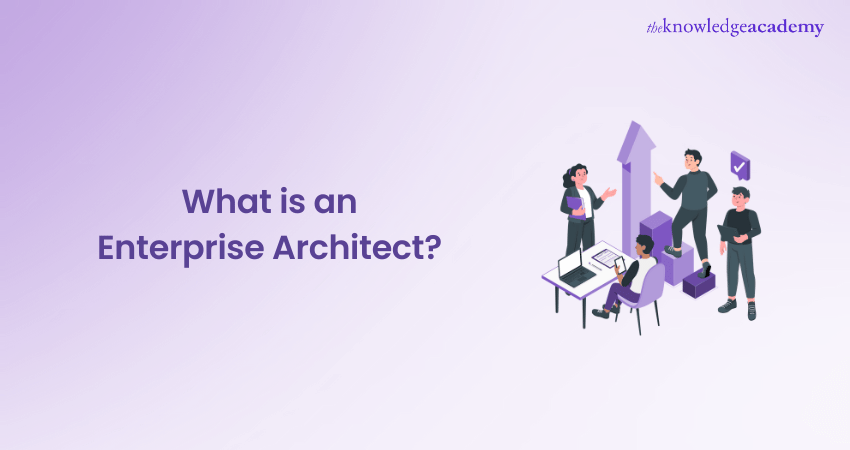
Do you want your organisation to stand apart from the other organisations? Do you plan on advancing your operations along with the changing market conditions? Then, an in-depth knowledge of What is an Enterprise Architect will help you achieve this goal.
According to the oracle of market trends, Grand View Research, the global stage of Enterprise Architecture is set to expand, growing at a CAGR of 4.9% from 2021 to 2028. This highlights the indispensable role of our Enterprise Architects, the master conductors orchestrating the symphony between IT and business strategy. In this blog, we will explore What is an Enterprise Architect, what they do, and the essential skills and qualifications needed for this role.
Table of Contents
1) What Does an Enterprise Architect do?
2) Responsibilities and Deliverables of an Enterprise Architect
3) What are Some Essential Skills and Qualifications of an Enterprise Architect?
4) Enterprise Architect Role Levels
5) The Impact of an Enterprise Architect on a Business
6) Enterprise Architect Salary
7) Enterprise Architecture Software
8) Conclusion
What Does an Enterprise Architect Do?
An Enterprise Architect (EA) plays a crucial role in aligning a company's IT infrastructure with its business goals. They are responsible for designing and overseeing the implementation of the organisation's overall IT architecture, ensuring that systems, processes, and technologies work together to support strategic objectives.
Enterprise Architects analyse the current state of a company's technology environment, identify gaps or inefficiencies, and develop roadmaps for improvements. They also create blueprints for IT projects, ensuring that each initiative fits within the broader strategy and follows industry best practices. This role involves collaborating with various stakeholders, including business leaders, IT teams, and external vendors, to ensure seamless integration and scalability of solutions.
Additionally, Enterprise Architects focus on Risk Management, governance, and compliance, ensuring that IT systems are secure, reliable, and in line with regulations. By continuously evaluating emerging technologies, they also help organisations stay competitive, making informed decisions on tech investments that drive innovation and efficiency.
Responsibilities and Deliverables of an Enterprise Architect
Let’s have a detailed look at the responsibilities and deliverables of an Enterprise Architect:
1) Responsibilities of an Enterprise Architect
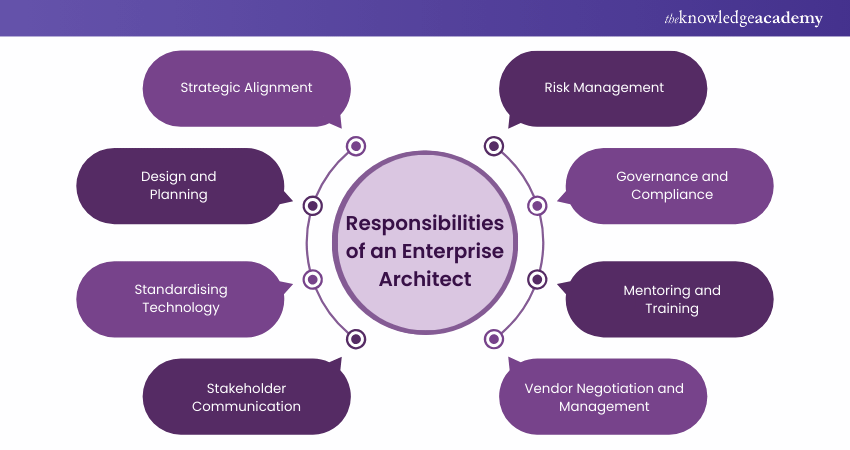
a) Strategic Alignment: The first and most important responsibility of an EA is to safeguard the alignment of the IT plan and the business plan. They are involved in converting business requirements to IT services as well as envisioning how the new technology can fulfil business needs in the future.
b) Design and Planning: EAs are responsible for creating an overview of the organisation's strategy, processes, information, and IT assets. This bird's-eye view allows them to design and implement solutions that cater to current and anticipated requirements.
c) Standardising Technology: To streamline operations and maintain consistency, EAs often work to standardise technology stacks across departments. They ensure interoperability and reduce complexities in IT infrastructures.
d) Stakeholder Communication: Bridging the gap between technical and non-technical stakeholders, EAs communicate complex technical strategies in a comprehensible manner. This also ensures everyone is aligned with the technological roadmap.
e) Risk Management: Knowing possible technological weaknesses, risks are determined by the Enterprise Architects. They also make sure that proper measures are taken to avoid any interruptions.
f) Governance and Compliance: EAs make sure that IT systems are compliant with the regulations and industry standards. They often set guidelines and frameworks to uphold these standards consistently.
g) Mentoring and Training: Given their vast experience and knowledge, EAs often play a role in training teams and individuals. They also make sure that the best practices in both technology and strategy are disseminated throughout the organisation.
h) Vendor Negotiation and Management: EAs often engage with third-party vendors. They help in the selection of services, tools, or platforms that align with the organisation's architecture. Their understanding of the broader picture allows for more informed decisions in this realm.
2) Deliverables of Enterprise Architect
a) Business Capability Mapping: Develop capability maps based on EA best practices and identify applications associated with each capability.
b) IT Landscape Analysis: Identify and manage all applications, dependencies, and data flows within the organisation.
c) Migration Planning and Roadmaps: Develop comprehensive roadmaps, considering all dependencies, for transitioning from legacy systems to new ones, such as migrating from SAP ECC to S/4HANA.
d) Current vs. Future State Diagrams: Construct diagrams that depict the current and envisioned future architecture.
e) Application Importance Reports: Generate reports to highlight the significance of applications within the IT landscape.
f) Lifecycle Roadmaps of IT Landscapes: Evaluate applications based on their business criticality and their functional & technical suitability.
Learn more about Enterprise Architecture – Register now for our Enterprise Architecture Green Belt Course.
What are Some Essential Skills and Qualifications of an Enterprise Architect?
After learning about What is an Enterprise Architect, it’s time to learn about the essential skills and qualifications that are required by an EA. Here's a detailed look at these skills and qualifications:
1) Essential Skills of an Enterprise Architect
The essential skills for an Enterprise Architect are as follows:
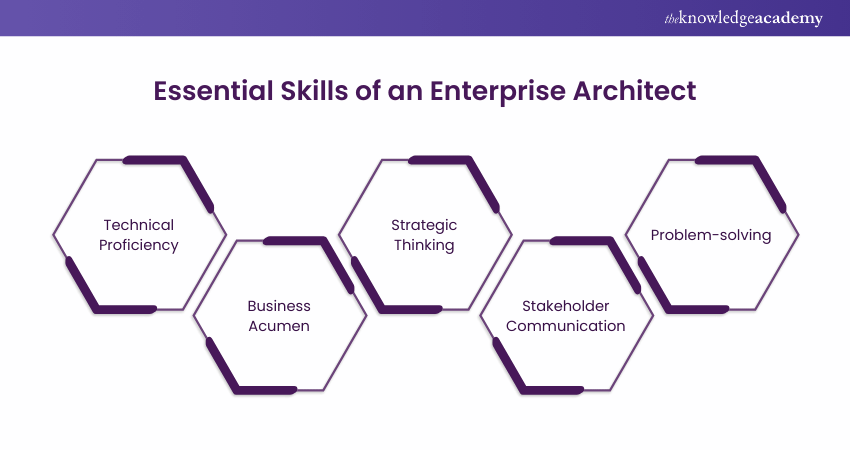
1) Technical Proficiency: An Enterprise Architect must be well-informed about IT frameworks, technologies, SDLC, and system interconnections.
2) Business Acumen: An EA needs to know the difference of business processes, objectives and plans to know how to position the IT environment to support organisational direction.
3) Strategic Thinking: Ideally an EA should be able to forecast future problems and future technological trends. They must understand how to design architectures that will address the current capacity requirements of the system and the expected future capacity requirements.
4) Stakeholder Communication: An EA should always be able to explain what various technical terms mean so that the different departments can understand and accept the points that are being made.
5) Problem-solving: Due to the broad perspective of the organisation, an EA is usually the first to address the issues which are related to the systems’ integration and other IT problems.
6) Leadership and Teamwork: They usually supervise important initiatives and interface with different departments; Leadership skills combined with team orientation are crucial.
7) Analytical Skills: An EA should also assess periodically the prospect and effectiveness of IT environments. They need to have the capability to analyse multifaceted information and draw corresponding conclusions.
8) Project Management: Project Management is an essential competency required in any EA and is particularly important for timely and on-budget deliveries.
9) Change Management: An EA should be adept at guiding organisations through change, ensuring smooth transitions while implementing new systems or architectures.
10) Continuous Learning: The technological domain is ever-evolving. An EA's commitment is to continuously update themselves with advanced trends.
Essential Qualifications of an Enterprise Architect
The essential qualifications that are required to become an Enterprise Architect are as follows:
1) Formal Education: To work as an Enterprise Architect, you should have a relevant Bachelor's Degree in a subject like Computer Science, Information Technology, Business Informatics, or any Engineering discipline. Many also have Master’s Degrees in Business Administration or Information Systems, which combines technology knowledge and business understanding.
2) Certifications:
a) Certified Information Systems Security Professional (CISSP): While being a security certification first and foremost, this certification helps the EA know about IT security, which is a critical qualification required to become an EA.
b) Azure Solutions Architect Expert: Since organisations have shifted focus towards cloud solutions, becoming certified by the leading cloud vendors may help establish an EA’s competency in today’s cloud environments.
c) Zachman Framework: This framework provides a framework for perceiving, organising, and defining an enterprise, and certification proves strategic structuring capabilities.
d) Work Experience: EAs must have accumulated years of experience in roles such as Software Development, IT Project Management, Systems Architecture, or IT Management before transitioning to the role of Enterprise Architect.
e) Business Training: Some EAs opt for business training or even MBAs to strengthen their understanding of the business side of organisations. This helps them make their architectural plans align with business goals.
f) Industry-specific Knowledge: Depending on the sector (e.g., finance, healthcare, manufacturing), EAs might need qualifications or training related to that industry's regulations, challenges, and systems.
g) Soft Skills Training: Many EAs undertake courses in Leadership, communication, and Change Management, given the significance of these skills in their roles.
Unlock your potential as a business-tech visionary- Register for our Enterprise Architect Training.
Enterprise Architect Role Levels
There are four Enterprise Architect role levels, each with increasing responsibilities and expertise, from Enterprise Architect to Principal Enterprise Architect. Understanding these levels helps professionals map out their career progression or gain insights into the roles within the Government Digital and Data profession. Below, each role level and its key responsibilities are explained in detail.
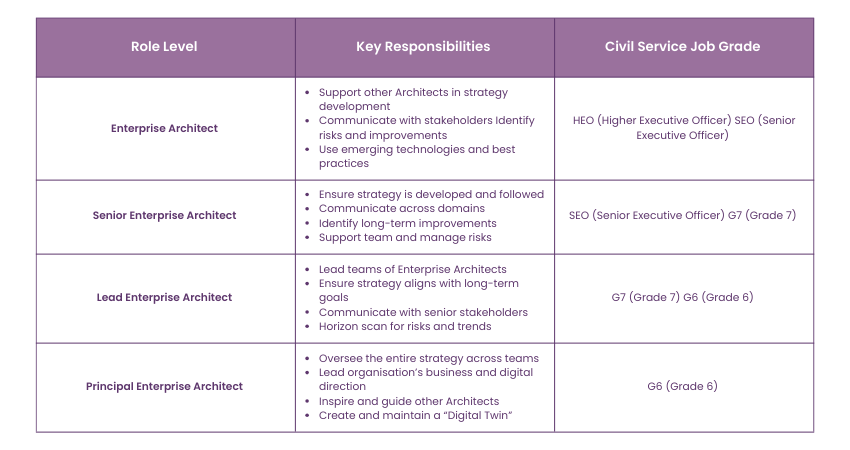
1) Enterprise Architect
An Enterprise Architect is the entry-level role in this field. At this stage, professionals focus on supporting other Architects in developing and implementing the overall strategy of the organisation.
Key responsibilities include communicating with stakeholders, identifying opportunities for improvement, and applying best practices. Additionally, Enterprise Architects work with emerging technologies and learn to identify risks that could impact the business.
They contribute to the successful delivery of the team’s objectives, ensuring projects align with organisational goals. This role is typically performed at the HEO (Higher Executive Officer) or SEO (Senior Executive Officer) Civil Service job grades.
2) Senior Enterprise Architect
A senior Enterprise Architect has more responsibility, working closely with Lead Architects to ensure that the enterprise strategy is not only developed but also properly followed. They play a crucial role in networking with stakeholders, identifying improvements, and actively supporting the community or team they are part of.
In this role, the Architect ensures the strategy aligns with long-term organisational objectives. Senior Enterprise Architects also play an active part in managing risks and ensuring the successful execution of the long-term strategy. This role is typically associated with the SEO (Senior Executive Officer) or G7 (Grade 7) Civil Service grades.
3) Lead Enterprise Architect
Lead Enterprise Architects operate at a high level, with responsibility for overseeing the development, agreement, and implementation of strategies across the organisation. They work with senior stakeholders, scanning for influences or risks that could affect the business and digital capabilities.
They also lead teams of Enterprise Architects, ensuring they understand how to meet the organisation’s goals. Lead Enterprise Architects are proactive in horizon scanning for emerging technologies and best practices that could benefit the organisation. This role is typically performed at the G7 or G6 Civil Service grades.
4) Principal Enterprise Architect
At the top of the hierarchy is the principal Enterprise Architect, who operates at the highest level of responsibility. They are accountable for ensuring that the long-term strategy is developed, agreed upon, and followed across multiple communities and teams.
A principal Enterprise Architect leads the organisation’s overall direction of business and digital capabilities, identifying external influences and risks. They inspire and guide other Enterprise Architects, ensuring that strategies are effectively implemented.
The principal Enterprise Architect also plays a key role in creating and maintaining a “Digital Twin,” which involves simulating the digital and physical aspects of the organisation’s operations. This role is generally performed at the G6 Civil Service grade.
The Impact of an Enterprise Architect on a Business
An EA can hugely impact a business’s IT Architecture. Let's see how:
1) Strategic Alignment of Business and IT: An Enterprise Architect ensures that the business strategies and objectives are seamlessly integrated with IT strategies. This alignment means that technological initiatives and investments directly support business goals, ensuring optimised ROI and eliminating wasteful spending on misaligned IT projects.
2) Enhanced Agility: Businesses need to be Agile to respond to market changes, new challenges, or opportunities. By architecting flexible and scalable IT systems, EAs enable businesses to adapt quickly. This agility can be the stark difference between capturing a market opportunity or being left behind.
3) Risk Reduction: EAs can anticipate potential pitfalls and challenges in IT implementations. Their foresight ensures that businesses are prepared, reducing the risk of costly mistakes, data breaches, or system failures.
4) Optimised Operational Efficiency: EAs have a holistic view of organisational processes and systems. By identifying bottlenecks or redundancies, they can recommend solutions that streamline operations. This optimisation often translates to cost savings, faster delivery times, and improved service quality.
5) Future-Proofing the Business: Social technology is advancing at a greater pace. Therefore, any organisation that has not embraced its use may find itself irrelevant. In this sense, EAs are always aware of the new technologies and trends which are likely to affect the businesses and help to advise when and how it can help to stay ahead of time.
6) Improved Collaboration and Communication: With a bird's-eye view of the organisation, EAs can spot gaps or communication breakdowns. Their architectures often promote better data sharing and collaboration tools, fostering improved inter-departmental collaboration.
7) Governance and Compliance: Depending on the industry and job, such a formulation may be critical for compliance with regulatory requirements in the financial, healthcare, or e-commerce industry. These guidelines are implemented and followed by EAs to avoid possible legal consequences and protect the customers’ trust.
8) Cost Savings: Even though some of the recommendations that EA proffers for an organisation may call for capital investment initially, the gains in the long term are normally impressive, and, therefore, you reduce overall expenses. There could be an improvement in processes, removal of wasteful roles and redundancies, efficient management of software licenses, and better management of vendor contracts, among others.
9) Enhancing Innovation: On a broad scale, EAs enshrine innovative capabilities in organisations by establishing a strong and adaptable technological infrastructure. They also help to foster innovation by allowing the development and experimentation of new ideas that can be continually adjusted and deployed, propelling the business forward.
10) Stakeholder Satisfaction: First, through advanced systems and processes, organisations can improve delivery of services which results in more satisfied customers. Internally, the efficiency in production processes can mean increased happiness levels of the employees and their efficiency.
Enterprise Architect Salary
According to Glassdoor, the average salary for an Enterprise Architect in the United Kingdom is £50,362 per year. This figure can vary based on factors such as experience, location, and the specific industry. Additionally, Enterprise Architects often receive additional cash compensation, which can range from £5,495 to £13,881.
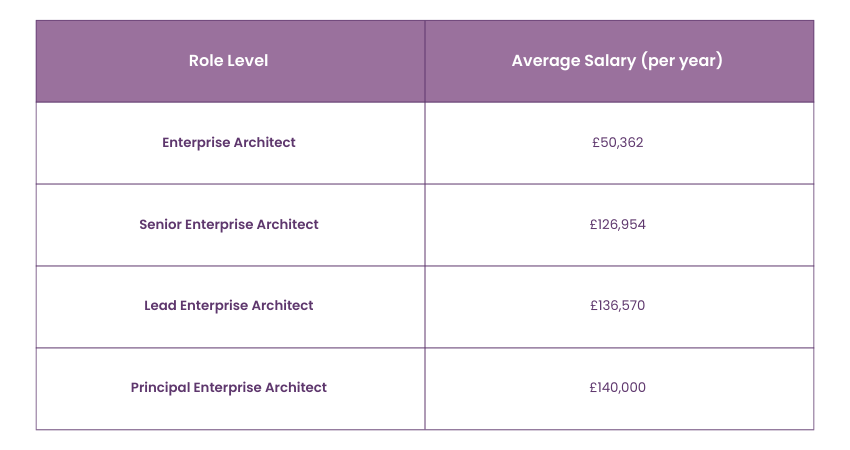
Enterprise Architecture Software
Enterprise Architecture (EA) tools are essential for businesses aiming to manage and streamline their current architecture while preparing for future technological advancements.
These tools facilitate collaboration, generate reports, run simulations, and perform tests to ensure that the Enterprise Architecture aligns with the organisation’s evolving needs. EA software also aids in creating visual representations, organising and cataloguing IT assets, and improving communication between departments.
With numerous EA tools available, here are some of the most popular options:
1) BiZZdesign Enterprise Studio
2) Software AG Alfabet
3) Sparx Systems Enterprise Architect
4) Erwin
5) Planview
6) Unicom Systems Architect
7) CrossCode Panoptics
These tools offer a range of features to help businesses optimise their IT infrastructure and improve overall efficiency.
Conclusion
An Enterprise Architect serves as a critical bridge between technology and strategic business goals. Their profound influence streamlines operations fosters innovation, and ensures that businesses remain agile, efficient, and poised for sustained success in a quickly evolving digital era. We hope that this blog helped you understand What is an Enterprise Architect in detail.
Gain advanced level knowledge of Enterprise Architecture with our Enterprise Architecture Black Belt Course.
Frequently Asked Questions

Yes, being an Enterprise Architect is a good job. It offers a strategic role in guiding technology and business alignment, excellent career growth opportunities, and high earning potential.

A Solution Architect focuses on designing specific solutions for business problems, ensuring they meet technical requirements. An Enterprise Architect, on the other hand, oversees the overall IT strategy, aligning technology with business goals across the organisation’s entire architecture.

The Knowledge Academy takes global learning to new heights, offering over 30,000 online courses across 490+ locations in 220 countries. This expansive reach ensures accessibility and convenience for learners worldwide.
Alongside our diverse Online Course Catalogue, encompassing 17 major categories, we go the extra mile by providing a plethora of free educational Online Resources like News updates, Blogs, videos, webinars, and interview questions. Tailoring learning experiences further, professionals can maximise value with customisable Course Bundles of TKA.

The Knowledge Academy’s Knowledge Pass, a prepaid voucher, adds another layer of flexibility, allowing course bookings over a 12-month period. Join us on a journey where education knows no bounds.

The Knowledge Academy offers various Enterprise Architect Training, including Certified Enterprise Architect Professional (CEAP) Training, Enterprise Integration Fundamentals Course and Enterprise Integration Practitioner Course. These courses cater to different skill levels, providing comprehensive insights into Enterprise Architect Skills.
Our Business Improvement Blogs cover a range of topics related to Enterprise Architect, offering valuable resources, best practices, and industry insights. Whether you are a beginner or looking to advance your Enterprise Architecture Skills, The Knowledge Academy's diverse courses and informative blogs have you covered.
Upcoming Business Improvement Resources Batches & Dates
Date
 Certified Enterprise Architect Professional (CEAP)
Certified Enterprise Architect Professional (CEAP)
Thu 20th Feb 2025
Thu 15th May 2025
Thu 31st Jul 2025
Thu 30th Oct 2025







 Top Rated Course
Top Rated Course



 If you wish to make any changes to your course, please
If you wish to make any changes to your course, please


